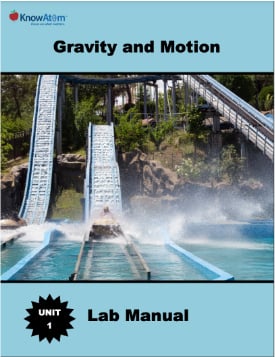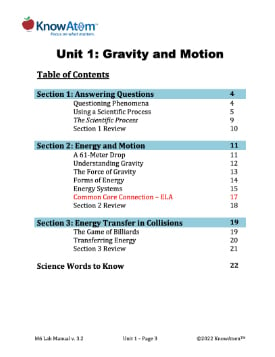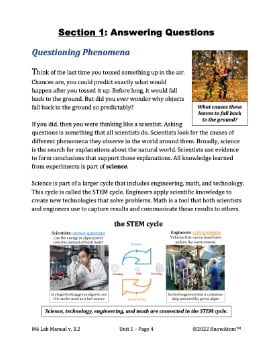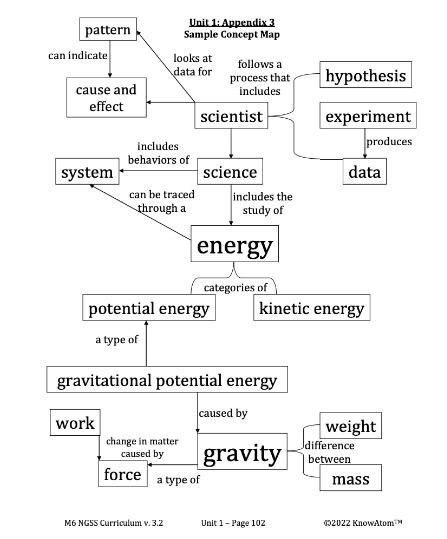The science background section gives teachers more in-depth information on the phenomena students explore in this unit. Below is an excerpt from this section on mass and energy transfer.
The idea of energy transformation and energy conservation can be understood by thinking about two objects that come into contact with one another. For example, when you drop a bouncy ball from up in the air to the ground, it forms a system with the ground. Its stored gravitational potential energy is transformed into kinetic energy as it falls to the ground.
When the ball hits the ground, the ground pushes back on the ball. This is because of Newton's Third Law of Motion, which states that for every action, there is an equal and opposite reaction. Action-reaction pairs occur whenever two objects come into contact. The force of the impact of the ball hitting the ground causes the ball’s shape to change because it is made of flexible rubber. As a result, the bouncy ball’s kinetic energy transforms to a form of potential energy called elastic energy, which is energy stored in objects when stretched. As the bouncy ball’s shape is restored, the elastic potential energy transforms back to kinetic energy and the ball bounces back into the air.
In a perfect system, the ball would bounce back to its original drop height above the ground. However, in the real world, the ball won’t bounce as high on the second bounce because some of the energy has transferred out of the system. As it moves through the air, drag causes some of the gravitational energy to transfer out of the bouncy ball system. When the ball hits the floor, friction transfers some more energy out of the system. Finally, at the moment the ball hits the ground, some of the energy is transferred out of the ball as it transforms to sound energy, which is energy produced by sound vibrations moving through a substance in waves.
The game of billiards is another way to understand energy transfer and energy conservation. You can think about the game of billiards as a system consisting of the balls and the table. The outside force of a person hitting the cue ball causes energy to transfer from the cue stick to the cue ball and then to the other balls. In a perfect system, the same amount of energy put into the cue ball is going to be conserved and transferred to the other balls. In the real world, some energy transfers out of the system because of friction caused by the white cue ball moving across the table, and drag as it moves through the air.
Whenever two objects come into contact with each other, both objects exert a force on each other. For example, when the cue ball hits another ball, the force of the collision transfers some of the kinetic energy into the second ball.
This transfer of energy changes the motion of the billiard balls. This is why the solid and striped balls begin to move after a break—the white cue ball has transferred kinetic energy that causes the other balls to move. If the cue ball is hit with a smaller force, it will have less energy to transfer to the other balls. If it is hit with a greater force, it will have more energy to transfer to the other balls.
The motion of the white cue ball after it hits another ball depends on how exactly it hits the other ball. For example, the cue ball will stop moving if it travels in a straight line and hits the other ball exactly in the middle of the other ball. This is because of energy conservation: all of the energy from the white cue ball is transferred to the other ball.
However, you’ll often notice in a game of billiards that the cue ball keeps moving after hitting another ball. This is because the cue ball did not hit the other ball exactly in its middle. As a result, not all of the cue ball’s energy is transferred to the other ball, so the cue ball keeps moving before friction eventually causes it to stop
Another factor that influences the energy of a moving object is its mass. You might notice that all of the balls on a pool table are the same mass. This is because the kinetic energy of a moving object is influenced by its mass.
Kinetic energy is proportional to mass. Proportion refers to the relationship between things, as to size, quantity, or number. The kinetic energy doubles as the mass of the object doubles, while the kinetic energy halves as the mass of the object halves. In other words, a more massive object moving at a certain speed has more kinetic energy than a less massive object moving at the same speed. Speed is the rate at which an object covers distance in a period of time.
As a result, a more massive object will apply a greater force in a collision, transferring more kinetic energy. The relationship between force and mass is described by Newton’s Second Law: force equals mass times acceleration. An object with greater mass needs more force to accelerate than an object with less mass.








